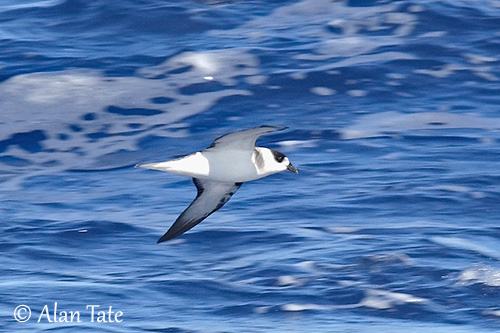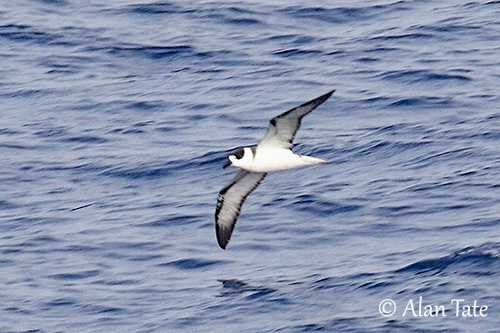
PROTECTION / THREATS / STATUS:
The White-necked Petrel is affected by invasive species. Cats and Brown Rats are an important threat for this species.
On the other hand, overgrazing by rabbits involved considerable erosion on Phillip Island, and despite their eradication, it is difficult for the White-necked Petrel to recolonise this island also degraded by domestic pigs.
The vegetation was also degraded by goats on Macauley Island, prior to their eradication.
These degradations make the habitat unsuitable for petrels during the nesting season, and it will take time for the habitat to become welcoming again for these birds.
The global population is roughly estimated at 150,000 individuals, and it is suspected to be increasing.
But currently, the White-necked Petrel is classified as Vulnerable, especially due to its small range including only two or three small islands.
Fr: Pétrel à col blanc
Ang: White-necked Petrel
All: Weißnacken-Sturmvogel
Esp: Petrel Cuelliblanco
Ita: Petrello collobianco
Nd: Kermadecwitnekstormvogel
Sd: vithalsad petrell
Photographers:
Alan & Ann Tate
AA Bird Photography
Text by Nicole Bouglouan
Sources:
HANDBOOK OF THE BIRDS OF THE WORLD vol 1 by Josep del Hoyo-Andrew Elliot-Jordi Sargatal - Lynx Edicions - ISBN: 8487334105
Petrels, Albatrosses, and Storm-Petrels of North America: A Photographic Guide De Steve N. G. Howell – Editor: Princeton University Press, 2012 – ISBN: 0691142114, 9780691142111 – 482pages
OISEAUX DE MER – Guide d’identification de Peter Harrison – Editions Broquet (Canada) – ISBN-10 : 2890004090 – ISBN-13 : 978-2890004092
Oceanic Birds of the World: A Photo Guide De Steve N. G. Howell, Kirk Zufelt – Editeur: Princeton University Press, 2019 – ISBN: 0691197016, 9780691197012 – 360 pages
Birds of Melanesia: Bismarcks, Solomons, Vanuatu and New Caledonia De Guy Dutson – Editeur: Bloomsbury Publishing, 2011 – ISBN: 1408152460, 9781408152461 – 448 pages
Wikipedia, the free encyclopaedia
Page family Procellariidae
Summary cards
White-necked Petrel
Pterodroma cervicalis
Procellariiformes Order – Procellariidae Family
INTRODUCTION:
The White-necked Petrel is not very well known, and its exact relationship to other petrel species is still unclear.
The present species with the Vanuatu Petrel and the Juan Fernandez Petrel were formerly regarded as conspecific. They are similar in appearance and overlap widely across C and S Pacific Ocean. But currently, the White-necked Petrel is a monotypic species.
It breeds in the Kermadec and Norfolk Islands. Following the breeding season, it disperses across tropical and subtropical Pacific Ocean. It is marine and pelagic, and comes to land only to breed on the higher parts of gentle slopes. It typically feeds on squid, but small fish is also probably taken.
The White-necked Petrel nests in burrows but also on the ground, depending on the location. Both adults are nocturnal at the colonies, and share the nesting duties.
The White-necked Petrel is mainly threatened by invasive mammalian species, killing the birds and degrading their habitat. Most of them have been eradicated, involving a slow increase of the population. But the species is currently listed a Vulnerable.

DESCRIPTION OF THE BIRD:
Biometrics:
Length: 41-44 cm
Wingspan: 102-110 cm
Weight: 450 g
The White-necked Petrel is a large, long-billed, long-winged and long-tailed gadfly-petrel.
The upperparts and the uppertail are grey to brownish-grey, but the upperwing is darker. A much darker M pattern is visible across greater and median coverts, tertials and rump.
The underparts are white. The underwing is bordered with black and the wingtip is black too. A blackish diagonal bar extends from the leading edge towards the body. The white undertail may show narrow black borders.
On the strongly patterned head, crown and head sides are black to just below the eye, whereas forehead, nape, chin and throat are white. We can see a broad, white collar contrasting with the black cap and the grey feathers of mantle and back.
The bill is black. The eyes are dark brown. Legs and basal part of the feet are pink, while rest of feet and outer toes are black.
In fresh plumage, the grey feathers of both mantle and back have white fringes. But in worn plumage, the adults look much darker above.
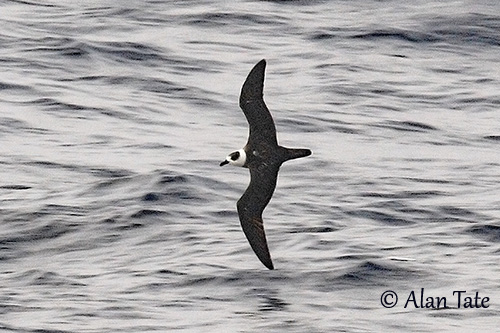
Male and female are similar.
The juvenile resembles adult, but it is very dark in fresh plumage with pale mantle.
The chick has pale grey to grey-brown down. The head is darker and the underparts are white.
RANGE:
The White-necked Petrel breeds on Macauley Island (Kermadec Islands) and a few pairs breed on Phillip Island (Norfolk group). During the breeding season, the species is often observed at sea near the Kermadecs, and in SW Pacific Ocean.
Outside of this period, it moves to the Northern Hemisphere, often to SE of Japan. It rarely occurs in C and E tropical Pacific Ocean.
HABITAT:
The White-necked Petrel breeds on oceanic islands, usually in the higher parts. The nests, burrows or rock crevices, are placed in low vegetation on gentle slopes.
Outside of the breeding season, it is marine and pelagic, often observed in areas of upwelling. It is rarely seen close to land during this period.
CALLS AND SONGS: SOUNDS BY XENO-CANTO
When at sea, the White-necked Petrel remains silent. But it becomes noisy while flying over the colonies, giving variant, loud flight calls described as “ooo kek kek kek kek kek”.
On the ground, a repetitive “eh eh eh” is usually heard, but on the nesting grounds, the calls may include various wails, growls, moans, squeaks and clucks.
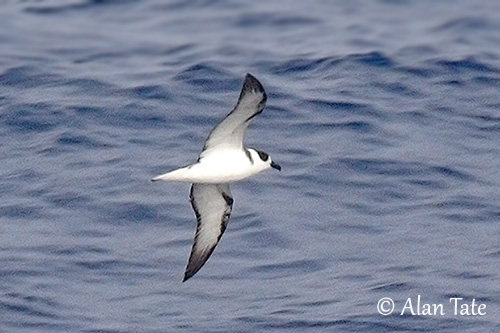
BEHAVIOUR IN THE WILD:
The diet of the White-necked Petrel is poorly known, but squid is part of it and small fish is also probably taken.
It is known for its way of fishing on the wing, picking fish and squid from near the surface. However, prey are probably also caught by surface-seizing, pattering and dipping, like most petrel species are doing.
It may forage with other Procellariidae such as shearwaters, as well as terns (Laridae). It does not follow ships.
The White-necked Petrel is monogamous and breeds colonially, sometimes alongside other species such as the Black-winged Petrel and the Wedge-tailed Shearwater.
The breeding behaviour is poorly known but both burrows and rock crevices are used as nests. Both adults share the nesting duties.
The White-necked Petrel is a transequatorial migrant. It can be seen in tropical and subtropical waters of NW Pacific Ocean, and occasionally N to Honshu in Japan, and mainly around the Ogasawara Islands and off Sakhalin, Russia.
Some birds occur in E in tropical waters, and it is reported to be abundant in C Pacific Ocean in May/November.
The White-necked Petrel performs a graceful and effortless flight with few wingbeats. The flight is slower and less frenzied, with fewer wingbeats, than small Petrodroma species.
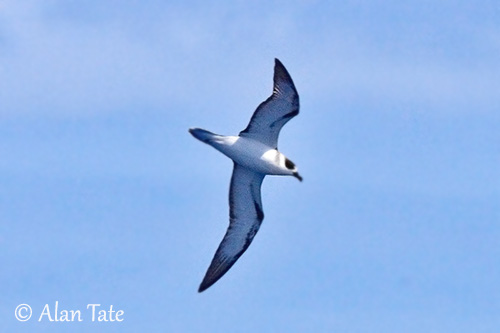
REPRODUCTION OF THIS SPECIES:
The breeding season starts in October/December. The adults perform a pre-laying exodus during a month, starting in November. The courtship displays occur in late November on Macauley Island.
The White-necked Petrel nests in burrows on Kermadec islands, whereas on Phillip Island (Norfolk group) it nests on the ground in crevices or among boulders. The nest-site is found in rocky areas, often with scattered understory below mature white oaks (Lagunaria patersonia of family Malvaceae).
The female lays a single, white egg in late December/early January (only January on Phillip Island). The incubation is roughly estimated to be about 50-55 days, shared by both adults in shifts of several days.
At hatching, the chick is covered in pale grey to grey-brown down. It is fed by both parents, and fledges about 100-115 days after hatching.
